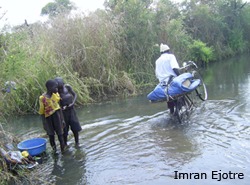SummarySchistosomiasis is a tropical disease of considerable public health and socio-economic importance in Uganda with four million people estimated to be infected. A study was conducted between October 2007 and March 2008 along the River Kochi in the West Nile Region of Uganda. Five sites, approximately 20km apart, were selected and data collected from families living close by. Stool examinations were analysed and examined each month from individuals over the age of four years. Snails living in the river were also sampled and those responsible for the transmission of bilharzia, namely Biomphalaria species, were screened for the presence of Schistosoma mansoni cercariae. Various environmental variables thought to be responsible for influencing the distribution of these snails along the river, namely water flow velocity, water pH, water temperature and concentrations of total dissolved solids in the water, were also recorded. |
||
|
The main objectives of this epidemiological study were to investigate effects of altitude, season and water environmental variables on the distribution of snails and to study associations between incidence of infection in Biomphalaria species of snails and the prevalence of bilharzia in human communities living along the river. The study also investigated infection prevalence rates in humans by age and gender. |
 |
|
|
This case study examines the suitability of the design and the methods of data management for this study and demonstrates how combinations of exploratory and descriptive methods and methods of multiple linear regression have been applied to answer the questions posed. An appendix adapts some of the data into a form to allow the method of logistic regression to be demonstrated too. |
||